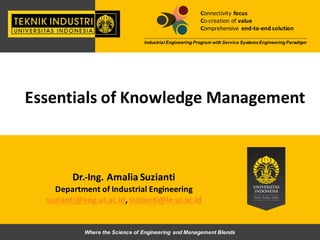
Knowledge Management Essentials
- 1. Dr.-‐Ing. Amalia Suzianti Department of Industrial Engineering suzianti@eng.ui.ac.id, suzianti@ie.ui.ac.id Where the Science of Engineering and Management Blends Connectivity focus Co-‐creation of value Comprehensive end-‐to-‐end solution Industrial Engineering Program with Service Systems Engineering Paradigm Essentials of Knowledge Management
- 2. Agenda • KM Importances • Types of Knowledge and Knowledge Conversion Process • KM Processes • Four Pillars of KM • KM Tools and Technology Framework
- 3. Why do we need to manage knowledge? Increasing market place Reductions in staffing Competitive pressures Time available diminished Early retirements and increasing mobility Manage increasing complexity Changes in strategic direction … Knowledge based Economy
- 4. Agenda • KM Importances • Types of Knowledge and Knowledge Conversion Process • KM Processes • Four Pillars of KM • KM Tools and Technology Framework
- 6. Knowledge Conversion Processes: SECI Model
- 7. Agenda • KM Importances • Types of Knowledge and Knowledge Conversion Process • KM Processes • Four Pillars of KM • KM Tools and Technology Framework
- 8. KM Processes Traditional Knowledge Based Economy
- 9. Agenda • KM Importances • Types of Knowledge and Knowledge Conversion Process • KM Processes • Four Pillars of KM • KM Tools and Technology Framework
- 10. Four Pillars of KM (Uriarte 2008) Management and Organisation Infrastructure People and Culture Content management System
- 11. Four Pillars of KM 1. Management and organisation The first and most important pillar of knowledge management is the commitment at the highest levels of management. The commitment from top management can come in two ways. Firstly, the managers at the highest levels should serve as role models by sharing and using knowledge themselves. Secondly, a structure to support knowledge management should be implemented, including financial, technological and human resources. One way is to create a knowledge management department and designate a Chief Knowledge Officer (CKO). Another aspect of the management-organization pillar is the management of the value chain, which is a critical enabler for knowledge management. The concept of value chain arises from the fact that organizations do not exist in isolation. They form links joined together in value chains. In these value chains every organization has customers while at the same time being a customer of other organizations. Every organization has to manage the organizational knowledge relating to its customers and suppliers. Such knowledge is generally referred to as customer knowledge, which must be generated, organized, shared and applied – in other words, managed. The main enabling practice with regard to this type of knowledge is customer relationship management.Effective management requires that a rich relationship with customers should be firmly established. In terms of the knowledge management process, this means making sure that the preferences of customers and the feedback that they provide are known to all the relevant persons within the organization.
- 12. Four Pillars of KM 2. Infrastructure All knowledge management systems require a certain level of technology and infrastructure support to be effective. As business processes become increasingly complex, knowledge management can be fully implemented only when appropriate information and communication technologies are available. An adequate ICT infrastructure is needed in order to better create, organize, share and apply knowledge. In any knowledge management system, three principal technology infrastructures are needed. These are: firstly, the technology infrastructure needed to organize content;; secondly, the technology infrastructure needed to search information, once organized;; and thirdly, the technology infrastructure needed to locate appropriate expertise.
- 13. Four Pillars of KM 3. People and Culture People and culture as an enabler ofknowledge management requires three important elements. These are: (a) the redefinition of organizational structure, (b) the corresponding human resource practices, and (c) a consistent organizational culture. The first element, organizational structure, determines the manner by which decision is made as well as the accountability for material and human processes and resources. The second element, human resources management practices, includes acquiring (recruitment), enabling (training), evaluating (performance measurement), developing (career management) and rewarding (compensation) the knowledge workers. In order for the third element – a consistent organizational culture – to flourish, it is important to create a climate of trust and an environment of openness where continuing learning and experimentation are valued, appreciated and supported by everyone in the organization.
- 14. Four Pillars of KM 4. Content management system Content management systems include information assets both internal and external and systems that support the creation and administration of digital information. To ensure the proper functioning of the knowledge management system, programs for managing the content of web sites should be developed and implemented. At the same time, the roles and responsibilities for maintaining and updating content should be clearly delineated. There should also be a way to allow “authors” or “contributors” to provide new content in the form of articles. Content management systems also include some concepts of workflow for target users which define how content is to be routed around the system.
- 15. Agenda • KM Importances • Types of Knowledge and Knowledge Conversion Process • KM Processes • Four Pillars of KM • KM Tools and Technology Framework
- 16. KM Tools and Technology Framework
- 17. Everybody is a genius. But if you judge a fish by its ability to climb a tree, it will live its whole life believing that it is stupid. (Anonymous) Be different … a better different